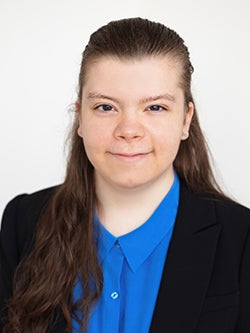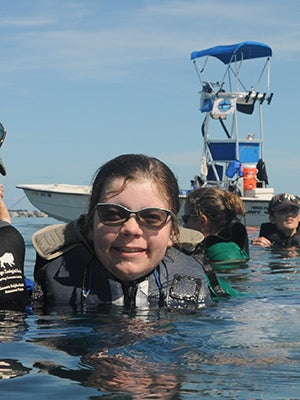Undergraduate Research
Larissa Michel ’23
OUR Featured Researcher: Larissa Michel ’23

Larissa Michel (she/her) is majoring in biology and violin performance. She conducts research under the mentorships of Associate Professor of Biology Angie Roles and Laela Sayigh from the Woods Hole Oceanographic Institution. Her project is titled “Vocal copying responses of bottlenose dolphins (Tursiops truncatus) to auditory playbacks of signature and non-signature T. truncatus whistles.”
Please describe your project:
signature whistles (function to convey identity information) and non-signature whistles (function presently unknown). They are also adept at copying other dolphins’ whistles. Currently, knowledge about copies is limited. My project aims to further the understanding of the context of whistle copy production in bottlenose dolphins.
I investigated whether bottlenose dolphins produce copies in response to playbacks of signature or non-signature whistles, using subsets of playback experiments generated between 1989-2014 at Sarasota Bay (Florida) capture-release health assessments. I visually identified all signature and non-signature whistles and potential copies that occurred in each of 59 thirteen-minute playback periods. Copies were independently verified by six naïve observers scoring the similarity of response whistles to stimuli on a five-point scale. I then examined the association between copy presence/absence and contextual variables such as sex, stimulus whistle type, and recording context using Fisher’s Exact tests.
A brief summary (the elevator speech) of your research project:
My research explores whether, and in what contexts, bottlenose dolphins copy other dolphins’ whistles. I am examining recordings of playback experiments, where pre-recorded whistle stimuli were played to a dolphin, whose vocalization responses were recorded with a hydrophone. I am specifically interested in copy responses to the stimuli, where the dolphin mimicked the pre-recorded whistle.
Why is your research important?
In the field of cetacean bioacoustics, the more we know about vocalizations, the better informed we can be about how to develop proper mitigation strategies for oceanic anthropogenic noise to preserve and protect populations of (endangered) species. Looking at this research through a different lens, the more we learn about non-human mammal complex social communication and the behavioral and neurological processes underlying auditory-vocal feedback, the more evidence there is supporting the idea that vocal learning evolved across many taxa (including humans). Learning about the mechanisms underlying vocal learning has medical and treatment implications for people who are hearing impaired or cannot properly form speech.
What does the process of doing your research look like?
My research involves a lot of computer work; most of my time is spent visually scanning spectrograms of recordings for particular types of whistles, and following a procedure to box and label them in a standardized manner. Analysis is also computer-based.
What knowledge has your research contributed to your field?
There is a statistically significant relationship between stimulus type (signature/non-signature whistle) and copy production (yes/no copy produced), with dolphins being about 8.4 times more likely to produce a copy in response to a non-signature whistle stimulus than in response to a signature whistle one. There is also a statistically significant relationship between sex (F/M) and recording context: females are more likely to be captured as part of a group than are males.
There was no significant relationship between sex and copy production, recording context (group of dolphins/individual dolphin) and copy production, stimulus type and sex, or stimulus type and recording context.
 In what ways have you showcased your research thus far?
In what ways have you showcased your research thus far?
I will be giving an oral presentation of my research at the 2023 Midwest Ecology & Evolution Conference (March 31 – April 2, 2023), as well as during the Biology Department Honors Research Seminars on April 17. In November 2022, I gave an oral overview presentation of my project, as did the other Biology Honors candidates.
How did you get involved in research? What drove you to seek out research experiences in college?
I went to an IB high school, and during our senior year we had to complete an “Extended Essay” in a subject of our choosing that was essentially an independent research project. That was my first real experience with bioacoustics, and with long-term research projects – and I figured a lot of it out independently, as no one in Michigan works with beluga whale bioacoustics. I loved the problem-solving aspects, and the feeling of discovering something new. I ended up presenting that research at the poster session of the 2018 International Association of Aquatic Animal Medicine conference, after which I was invited to participate in the June 2018 Sarasota dolphin health assessments, during which I fell in love with the fieldwork aspect of research.
In college, I knew I wanted to continue doing research for the same reasons I loved it in high school – the satisfaction of long-term work leading to new discoveries; fieldwork opportunities; learning about and working with the mammals I love. Along the way, I have discovered something else I love about research – the sense of contributing knowledge that is helping to make the world a better place.
What is your favorite aspect of the research process?
My favorite aspect of research is sharing it with others. I absolutely love seeing the curiosity in others about the work that I do, and in helping them understand why it’s valuable work.
How has working with your mentor impacted the development of your research project? How has it impacted you as a researcher?
Working with Dr. Sayigh (Woods Hole Oceanographic Institution: remotely in the summer of 2021 and in-person in the summer of 2022) helped me learn a great deal about bottlenose dolphin vocalizations, how to recognize them on spectrograms, and where opportunities exist for further study. She has years of experience in going to the Sarasota health assessments, doing computer work with spectrograms and analysis, and writing papers for publication, so she knows the field well and was able to help guide me towards an approachable topic. Dr. Roles has been involved this academic year in advising me on data analysis, writing my proposals, presentations, and thesis, and everything in between. It has been vital to have her guidance.
Importantly, having these two strong women as mentors and role models has been invaluable in encouraging me to pursue a research career.
How has the research you’ve conducted contributed to your professional or academic development?
This research has improved my patience, my problem-solving skills, and my presentation skills. Like in any research, I encountered challenges, and on many occasions, I did something incorrectly on the first try. It was valuable to learn that I am not defined by my first attempt – I can learn quite a lot of useful information from “failure”, and use what I learned to improve my next attempt.
What advice would you give to a younger student wanting to get involved in research in your field?
I would advise them to apply for summer internships at research laboratories such as the Marine Biological Laboratory (MBL), Woods Hole Oceanographic Institution (WHOI), Shoals Marine Laboratory, or anything else that you can find (Google is your friend). The Oberlin Biology Department has summer scholarships for attending marine field stations! Don’t be afraid to cold-email researchers with whom you are interested in working. Also, read papers published about topics in which you are interested. It’s great practice for when you need to do a lot of background research for something like a thesis or a literature review, and it will also help you determine your field(s) or sub-field(s) of interest.